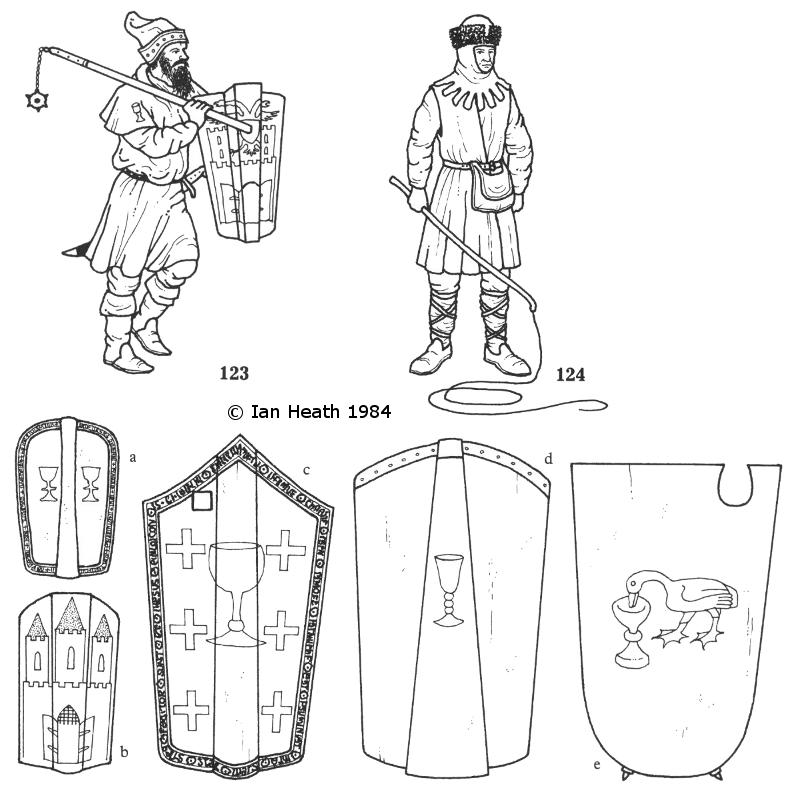
Try Amazon Audible Plus
HUSSITE WAGON SOLDIERS
An extract from Armies of the Middle Ages, Volume 2by Ian Heath
| [Based on a Taborite brethren, Hussite, 15th century Bohemia] | [Based on a Hussite soldier on a carved stove tile] |
 | |

| [Based on a Taborite brethren, Hussite, 15th century Bohemia] | [Based on a Hussite soldier on a carved stove tile] |
 | |
123 & 124. HUSSITE WAGON SOLDIERS
At the start of their revolt the majority of Hussites were armed with little more than peasant weapons, with slings, bills, scythes and, above all, flails predominating. In fact the Bohemians were noted for their military flails even before the Hussite wars - Konrad Kyeser, for example, at the time living in Bohemia, recommended the use of flails in his military treatise of 1405 - and the Behemisch drischel (‘Bohemian flails’) subsequently achieved a notoriety that was to last right up to Maximilian’s time. The Hussites called their flailmen cepnici, and one such is depicted in 123, based on a contemporary drawing of one of the Taborite brethren. One detail worthy of notice is the small red chalice, the symbol of the Hussite movement, embroidered on his hood for identification, seemingly a common practice amongst the Hussites. His pavise (pavézy) and secondary armament are added from other sources, the latter being a variety of short, slightly-curved, single-edged sword popular in Slavic countries as far apart as Bohemia, Poland and Serbia. The pavises shown in 123a-e demonstrate the considerable variation in the size and shape of such shields; the larger ones (sometimes called taras in Bohemia) would have been used by crossbowmen and handgunners, while the smaller ones were for other foot-soldiers and horsemen. They were usually brightly painted and often had biblical texts in Gothic script running round the rim as in 123a and c. All of those shown here carry Hussite motifs - the chalice on 123a, c and d, variously painted in yellow, red or black and often accompanied by stylised blood-drops; the goose on 123e (see note to 129d); and the Taborite symbol of a white castle with open gates on 123b and the pavise held by the main figure, which has in addition an escutcheon and double-headed eagle. The use of a small escutcheon to display the arms of a particular town or lord was commonplace. Other shields bore instead St Wenceslas or David and Goliath, or even a combination of these motifs with a chalice and/or an escutcheon, and all usually had decorative backgrounds of scroll-like foliage or geometric patterns. Surviving examples confirm that many were elaborately painted with a plethora of minute detail.
124, based on a Hussite stele, is a wagon-driver, complete with his long whip. He wears typical 15th century Bohemian dress, in this instance comprising a characteristic sleeveless, cross-over style topcoat, plus a hood and fur-brimmed cap. The large wallet-cum-satchel at his belt was apparently also typical if 19th-20th century Czechoslovakian paintings can be trusted. Wagon-drivers customarily rode the near-side rear horse of a four-horse team.
Note that neither of these figures wears any form of metal armour, which fits with a contemporary German chronicler’s description of Zizka’s troops as ‘peasantry without proper armour, using only flails, clubs, crossbows and spears.’ However, the Austrian ordinance of 1431, doubtless copying Hussite practice, specifies that as well as a sword, knife and ‘iron hat’ each wagon soldier must equip himself with a pair of iron gauntlets and a breastplate or at least a Schiessjoppen or padded jupon. In addition each handgunner had to bring one pound of bullets and each crossbowman a minimum of 10 bolts.